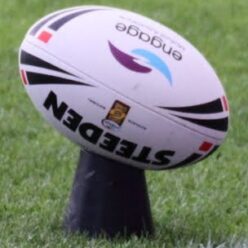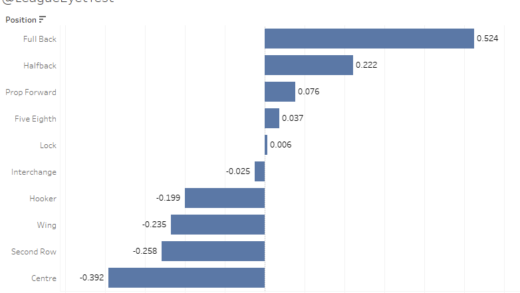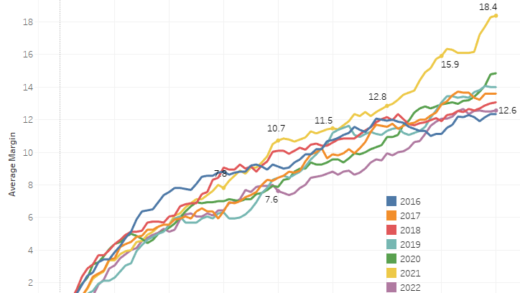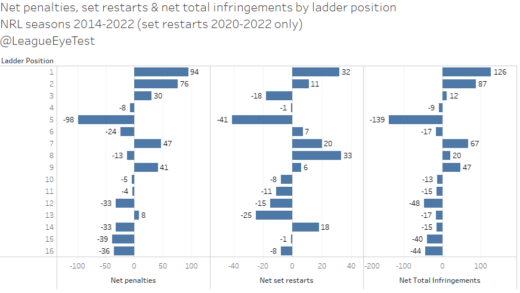On a recent episode of the Upfront Podcast (please like and subscribe), NRLW star and first ballot Eye Test Hall of Famer Millie Boyle was asked about the possibility of using a smaller ball and it prompted a very interesting discussion.
Rather than recap her answer, the video of the question is below.
It does raise a great point, if we want to improve the NRLW product, a smaller ball may help introduce some of the more spectacular tries we see in the NRLM. And what’s more exciting than seeing a big forward running down an edge with the ball in one hand? Well maybe a kicking duel. But I digress.
It’s not a new theory, as Brad Fittler was talking about it in 2020 in a way only Freddy could.
“They have to make the ball smaller, it seems ridiculous,” Fittler said.
Just generally, women are smaller than men and the one thing I’ve found is the offloading – obviously the men from carrying the ball and practicing carrying the ball with one hand – I don’t think women’s hands are as big as men’s, would that be right?
I’m not sure what the women think of that, but I just think it makes sense.
It doesn’t make the competition any different, it just makes it fairer…“
The idea is that the smaller ball will be easier to grip for NRLW players, encouraging more ball playing and offloading and opening up some of the diving one handed tries we see in NRLM.
Women’s leagues using smaller ball sizes or equipment isn’t unusual. The WNBA uses a size 6 basketball, the NBA uses a size 7. In women’s volleyball the net is 2.24m compared to 2.43m for men’s version. A women’s cricket ball is between 140-151 grams with a circumference of 21-22.5 centimetres, compared with 156-163g and 22.4-22.9 for the men’s game. AFLW uses a slightly smaller ball than the AFLM.
The smaller ball already exists. The NRLM standard 37-centimetre Steeden ball is the one that is used in both games, but a 34-centimetre ball also exists.
Using a smaller ball has also been discussed in rugby union. Shaunagh Brown, the former Harlequins and England prop thought the smaller ball would have helped.
“I would have offloaded a few more times during my career with a smaller ball. I would have taken more risks to pop the ball up or to use one hand when running with the ball.”
The smaller ball in women’s sport does make sense from a logical point of view. WNBA players are on average about 10% shorter than their male counterparts, measuring 5’11-6’0’ tall, while the average NBA player is height is 6’6” (although the emphasis on height in that league is taking a backseat to length).
The circumference of an NBA size 7 basketball is 75cm, whilst the WNBA size 6 ball is 72.5, a modest reduction. The WNBA also uses the shorter international three-point line compared to the NBA line which is over 40 centimetres further out at it’s peak.
Back to rugby league and player heights. The average (listed) height of an NRL player this season is 182.7cm and has actually dropped three centimetres since 2014. Who says the little man is being pushed out of the game?

The average height of an NRLW player 169cm this season and has barely changed over the last four seasons.

That is means the average NRLW player is about 8% shorter than an equivalent NRLM player, which means (on average) 8% smaller hands and 8% shorter arms, which could mean the ball is too large for them. Coincidentally, the drop from a 37cm Steeden to a 34cm ball would be almost an 8% reduction in size. Sounds perfect right?
But is it needed? Do NRLW players play more cautiously? One way to check if a smaller ball could be beneficial is to look at error rates for the NRLW competition, see how they have been trending over the years and also compare it to NRLM.
Error rate, as used by this site, is the average number of possessions (or touches/receipts) before an error is committed. Below is the average error rate by season for the NRLW since inception in 2018. Data for both NRLW and NRML is from Fox Sports Stats.

This chart certainly tells a story. The error rate for the first NRLW season was 28.88, meaning teams were committing an error every 29th touch of the ball. That jumped up to 31 the following season, before dropping back down to 30.07 and then back down to 28.30 in 2021.
The introduction of three new teams during that season seems to a reason for the slide, as it climbed back up to 32.44 in 2022 and is currently sitting at 33.96, the highest since the league’s inception. It is interesting to note that error rates didn’t go down with four new teams this season, which might have been a fear given the number debuting players. That does speak volumes for the improvement in pathways for NRLW players over this time.
The other important part of that number hitting 32 is that it nearly matches the men’s error rate. In 2014 the error rate for the NRL was 32.07, or one error every 32 touches. Pretty good for a league that’s been around for six years and less than 100 matches. The last ten NRLM seasons can be seen below.
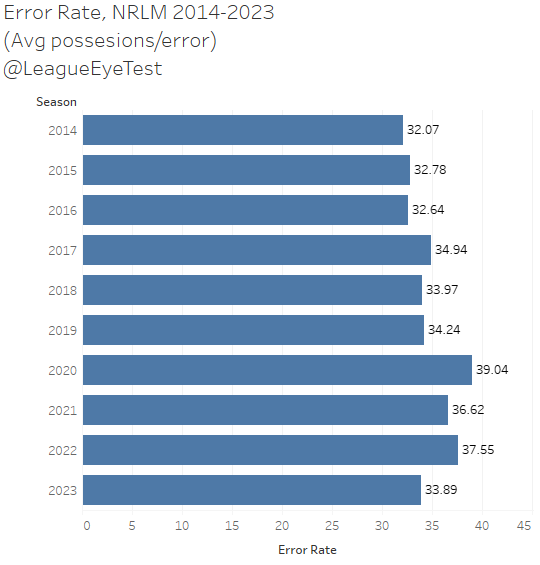
In 2023 it’s now nearly 34 touches per error. Error rate usually declines as the season progresses and team cohesion improves.
For the NRLW to reach parity here with only a few seasons of play, with semi-professional players is another feather in the cap for the league. Imagine what they could do with proper full-time wages and training?
The other aspect of the game we can look at is how often an offload occurs. If players feel the ball is too large, they may be less willing to try a risky pass. Below is the average number of runs per offload by NRLW season since the league started.
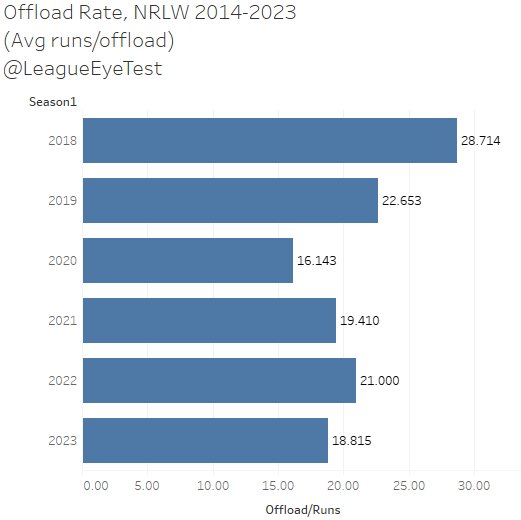
Perhaps unsurprisingly it’s almost the inverse of the error rate chart above. The fact the offload rate is decreasing – i.e., we’re seeing an offload every 18 runs rather than 28 – whilst the rate of errors is decreasing indicates the skill level of players is improving. Or their confidence in pushing passes after hitting the line is increasing. Either way it’s a positive sign for the women’s game in just six short seasons.
For offload rate, the number peaked at 28.71 in 2018, meaning one offload every 28 runs with the ball. That dropped down to one every 16 runs in 2020, before jumping back up again with the introduction of new teams in 2021.
Again, we’re not seeing that number increase in 2023, which is again points to a four-team expansion being the right move for this season.
Comparing offload rate to the NRLM sees a similar trend as error rate.

NRLW teams are actually offloading more often than the men’s game this season, with one offload every 16 runs, compared to one every 20 runs for the men’s game.
The reason these numbers are useful is that it normalises possession across both games. Average errors per game would be meaningless as there are 10 minutes fewer in NRLW, and no set restarts which means less ball in play time. Using a per possession metric enables like for like comparisons, which a per game average would not.
The exciting thing for me from these numbers is that the women’s game could get even better with a smaller ball if it improves ball handling and play making. If we’re seeing this level of skill with a regular sized ball, we could be seeing an even better version of the game with a smaller ball. For a game that is already more interesting to me than the homogeneous NRLM, the prospect of even more ball playing is enticing.
That isn’t to say that a smaller ball will solve every issue, and it might even create some unintended consequences. In women’s basketball, North American players have always played with a smaller ball. However, in Europe they only moved to a smaller ball for the women’s game in 2004. Some analysis of the numbers from that changeover identified that players didn’t shoot better with a smaller ball.
“Given the characteristics of the male and female body – primarily the gender-related difference in strength – the introduction of a smaller and lighter ball is an understandable and expected change. Despite all reasons in favour of introducing the size 6 basketball, the use of the smaller and lighter ball clearly does not improve shooting accuracy.”
There are concerns that a smaller ball could affect kicking, especially from the sideline. A study from Northern Michigan University in 2020 using rugby union balls found that “overall, a reduction in ball size reduced average and maximum force, contact time and work while contact distance did not change substantially”.
It’s one area that needs to be taken into account, as women’s players are less accurate in this aspect. NRLM kickers are converting at 78% this season, with NRLW hitting just 59% of their goal attempts. A possible solution for this might be ball with smaller dimensions but the same weight as the current one.
Even with the numbers above suggesting the women’s game is already progressing skill wise, trailing a smaller ball is a no brainer at this stage. If it enables players to be more creative and showcase their ballplaying skills, then it’s an easy win.
In comparing their error and offload rates with the NRLM it’s clear that the NRLW players are creating similar (or better) offload and error rates to their male counterparts. The skills are already there, we just need to give them every opportunity to show them.
But if you really wanted to reduce errors and promote more second phase play in the women’s game, you could simply pay them like the full-time professional athletes they’re expected to be. A smaller ball is part of the solution, not the whole thing.
Eye Test Excepted Point (ETXP)
I’m just posting the charts this week as due to the time taken for the above analysis. Enjoy, although Sharks fans can probably skip ahead.
St George Illawarra v Canberra
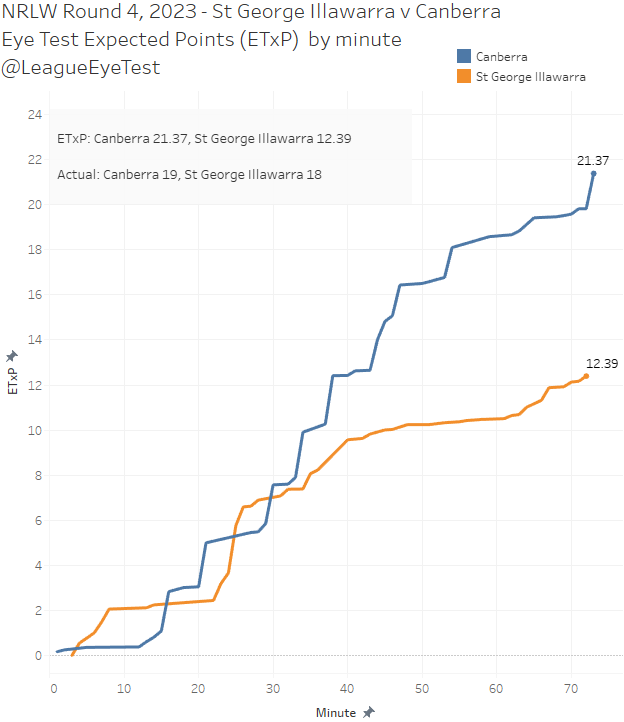
Wests Tigers v North Queensland

Parramatta v Brisbane

Sydney Roosters v Cronulla
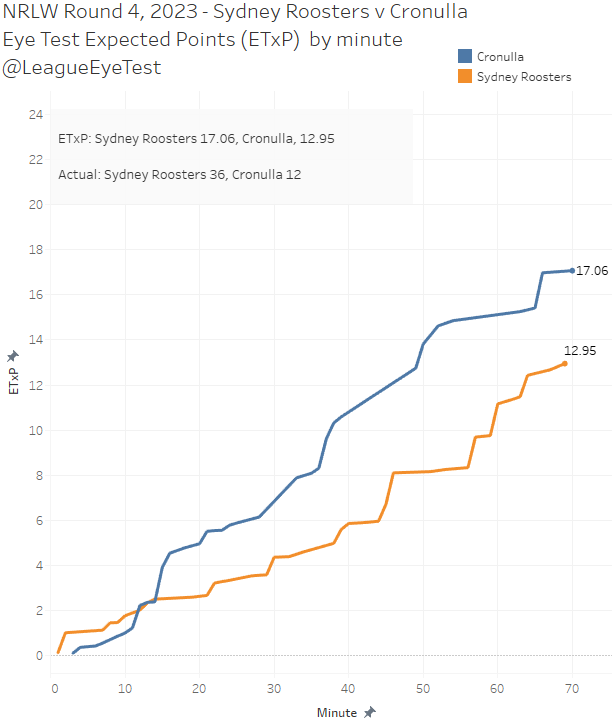
Newcastle v Gold Coast

Eye Test Player Contribution Rating (ETPCR)
The Roosters have locked out the top three spots, which isn’t unexpected seeing as they trounced the Sharks 36-12.

Isabelle Kelly was dominant with an ETPCR of +5.632, meaning she contributed that number of points to her team (adjusted for possession). Second place was Tarryn Aitken with an ETPCR of +4.173, with Jayme Fressard rounding out the top three with +3.103.
Only Newcastle fullback Tamika Upton split the Roosters this week, with her ETPCR of +2.955 pushing Corban Baxter to 5th place at +2.789.
On the bottom end of the scale, it’s a similar situation for the Sharks.

Kiana Takairangi had the lowest ETPCR this round at -6.530, lower than her teammate Andie Robinson at -3.721. Shannon Maru of the Eels had the third lowest score of -3.418 in Round 4, before a pair of Titans in Zara Canfield (-2.930) and Chantay Kiria-Ratu (-2.427).
Tackle Rate

Gold Coast’s Brittany Brealey-Nati was the most efficient tackler this round with a tackle rate of 51.05%. That indicates she completed a tackle on 1 out of every 2 play the balls whilst she was on field, which is an astonishing rate. Usually, these metrics drop as players see more time on field, and it’s rare for a player to push above 40% if they play more than half the game, let alone 50%.
Her teammate Georgia Hale wasn’t far behind at 44.95%, which is another astonishing number for a 70-minute player, and probably indicates where a lot the Knights traffic in attack was going during their victory. Parramatta’s Madeline Jones placed third with a tackle rate of 39.42%.
Ball Runner Rate
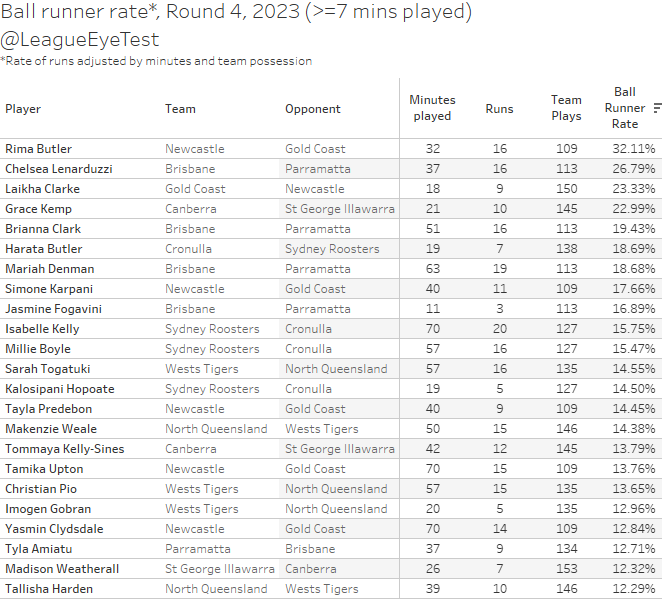
For ball runner rate, Rima Butler of the Knights took top place with a rate of 32.11%. This indicates she completed a run with the ball on nearly one in every three play the balls Newcastle had whilst she was on field.
Second place went to Chelsea Lenarduzzi of Brisbane at 26.79%, with Laikha Clarke from the Titans in third spot at 22.33%. Grace Kemp from Canberra was the only other player above 20% this round.
Total Run %

Butler also took out the top spot for Total Run % this round as well, once we add in her three option runs (decoy or support). Her 38.13% was 8% higher than second placed Lenarduzzi at 30.14%, and Kemp’s two option runs pushed her up into third place for this metric at 27.59%.
Involvement Rate
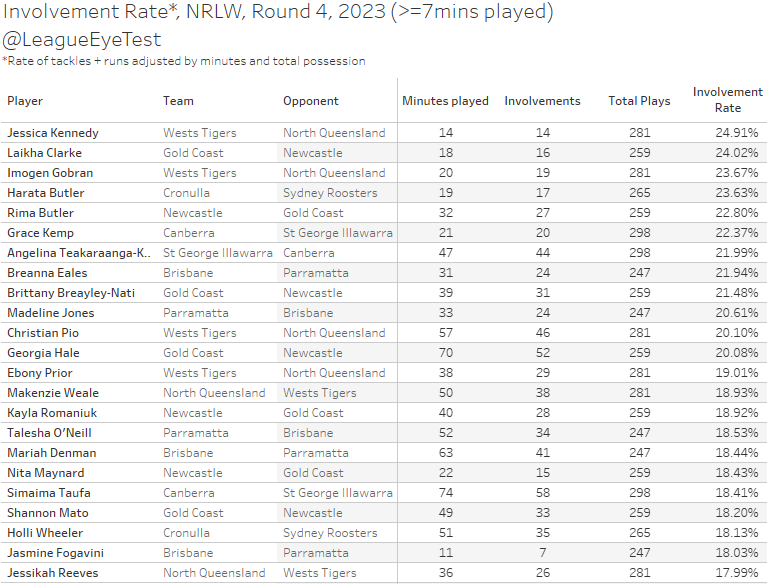
Jessica Kennedy of the Wests Tigers was the most active NRLW player this round, completing a run or tackle on 24.91% of plays whilst on field on the weekend. This indicates she made a run or completed a tackle on one in every four plays.
Second place went to Laikha Clarke from the Gold Coast at 24.02% and Wests Tigers Imogen Gorben followed with an involvement rate of 23.67%.
